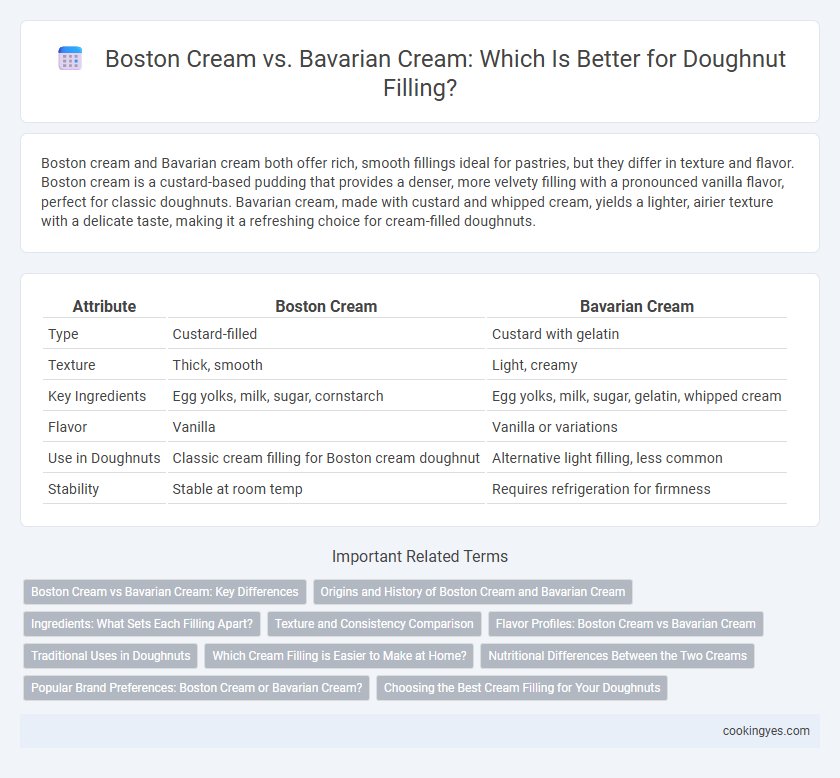Boston cream and Bavarian cream both offer rich, smooth fillings ideal for pastries, but they differ in texture and flavor. Boston cream is a custard-based pudding that provides a denser, more velvety filling with a pronounced vanilla flavor, perfect for classic doughnuts. Bavarian cream, made with custard and whipped cream, yields a lighter, airier texture with a delicate taste, making it a refreshing choice for cream-filled doughnuts.
Table of Comparison
| Attribute | Boston Cream | Bavarian Cream |
|---|---|---|
| Type | Custard-filled | Custard with gelatin |
| Texture | Thick, smooth | Light, creamy |
| Key Ingredients | Egg yolks, milk, sugar, cornstarch | Egg yolks, milk, sugar, gelatin, whipped cream |
| Flavor | Vanilla | Vanilla or variations |
| Use in Doughnuts | Classic cream filling for Boston cream doughnut | Alternative light filling, less common |
| Stability | Stable at room temp | Requires refrigeration for firmness |
Boston Cream vs Bavarian Cream: Key Differences
Boston cream is a pastry cream-based filling with a smooth, custardy texture and a vanilla flavor, commonly used in Boston cream doughnuts topped with chocolate glaze. Bavarian cream combines custard with whipped cream, creating a lighter, airier texture and often incorporates gelatin for stability, making it ideal for layered desserts as well as doughnut fillings. The main differences lie in texture and richness, with Boston cream being denser and Bavarian cream more delicate and fluffy.
Origins and History of Boston Cream and Bavarian Cream
Boston Cream doughnuts are inspired by the Boston cream pie, a dessert invented in the 19th century by Chef M. S. Reed at the Parker House Hotel in Boston, combining vanilla custard and chocolate glaze. Bavarian cream, used as a doughnut filling, traces back to the 17th-century French dessert Creme bavaroise, a chilled custard thickened with gelatin and enriched with whipped cream. While Boston cream filling relies on a pastry cream base, Bavarian cream incorporates gelatin for a lighter texture, reflecting its European dessert heritage.
Ingredients: What Sets Each Filling Apart?
Boston cream filling combines rich vanilla custard made from egg yolks, sugar, milk, and cornstarch, delivering a creamy, pudding-like texture that perfectly complements the doughnut's fluffy exterior. Bavarian cream, however, features a base of thickened custard enriched with whipped cream and gelatin, resulting in a lighter, silkier consistency with a subtly sweet flavor. The key distinction lies in Bavarian cream's use of gelatin and whipped cream for a mousse-like finish, while Boston cream relies on a dense, cooked pudding approach.
Texture and Consistency Comparison
Boston cream filling features a smooth, custard-like texture with a thick, creamy consistency that holds its shape well inside doughnuts. Bavarian cream offers a lighter, airier texture due to its incorporation of whipped cream, resulting in a fluffy and delicate consistency. The denser, richer Boston cream contrasts with the softer, more mousse-like feel of Bavarian cream, impacting the overall mouthfeel of the doughnut.
Flavor Profiles: Boston Cream vs Bavarian Cream
Boston cream filling features a rich custard base with a pronounced vanilla flavor and a smooth, creamy texture that balances sweetness and creaminess. Bavarian cream offers a lighter, airy consistency with subtle vanilla notes, incorporating whipped cream for a fluffier mouthfeel and a more delicate taste. Both fillings complement doughnuts differently, Boston cream providing a dense, indulgent bite while Bavarian cream delivers a softer, less sweet flavor profile.
Traditional Uses in Doughnuts
Boston cream filling combines rich vanilla custard with a smooth chocolate glaze, traditionally used in Boston cream doughnuts to create a classic layered dessert experience. Bavarian cream, a lighter mixture of pastry cream and whipped cream, is commonly found in filled doughnuts offering a fluffier, more delicate texture. Both creams serve as iconic fillings, with Boston cream emphasizing a dense, indulgent profile and Bavarian cream providing a softer, creamier bite in doughnut varieties.
Which Cream Filling is Easier to Make at Home?
Boston cream filling consists of a custard-like mixture made primarily from milk, egg yolks, sugar, and vanilla, which requires careful temperature control but uses common pantry ingredients. Bavarian cream involves making a custard base combined with whipped cream and gelatin, adding complexity with gelatin preparation and setting time. For home cooks, Boston cream filling is generally easier due to its straightforward cooking process and lack of gelatin.
Nutritional Differences Between the Two Creams
Boston cream filling typically contains a custard base made from milk, eggs, sugar, and cornstarch, resulting in a lower fat content compared to Bavarian cream, which is richer due to the addition of whipped cream. Boston cream tends to have fewer calories and saturated fats, making it a lighter option for doughnut fillings. Bavarian cream's higher fat and calorie levels come from its creamy texture and heavy cream content, providing a richer mouthfeel but increased nutritional density.
Popular Brand Preferences: Boston Cream or Bavarian Cream?
Popular brands often favor Boston cream for its rich custard filling topped with a glossy chocolate glaze, creating a classic Boston Cream Doughnut. Bavarian cream, prized for its light, vanilla-flavored custard, is favored by brands seeking a smoother, less dense filling. Consumer preference trends show Boston cream doughnuts dominating mainstream markets, while Bavarian cream appeals more to gourmet and specialty bakeries.
Choosing the Best Cream Filling for Your Doughnuts
Boston cream filling combines rich vanilla custard with a smooth texture, delivering a classic, well-balanced flavor that pairs perfectly with fluffy doughnuts. Bavarian cream offers a lighter, airy consistency made from whipped cream and vanilla custard, providing a delicate sweetness ideal for those who prefer a less dense filling. Selecting the best cream filling depends on desired richness and texture, with Boston cream for a traditional, indulgent experience and Bavarian cream for a lighter, creamier bite.
Boston cream vs Bavarian cream for cream filling Infographic

 cookingyes.com
cookingyes.com